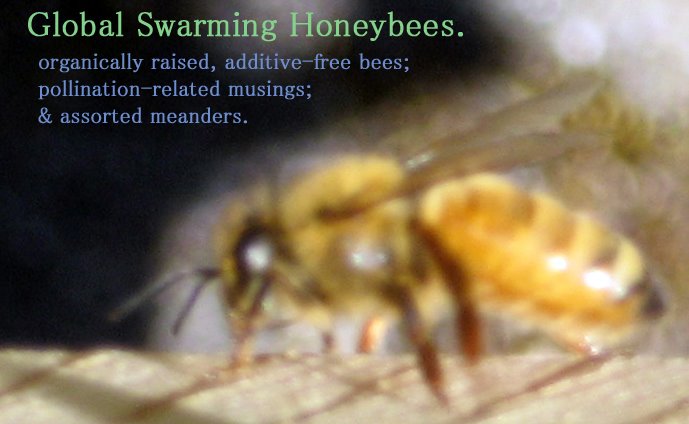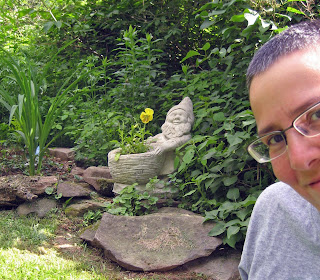We've seen it all before, the changing colors, the falling leaves. And yet, and yet.
I walk around the pond with cat and dog, thinking of James Schuyler's great field poem, "Salute," which ends with the lines: "Past/is past. I salute/that various field."
Which evokes Frank O'Hara's line, "Grace to be born and live as variously as possible." (These words are inscribed on O'Hara's gravestone, which I once had the honor of meeting in person.)
A field does live as variously as possible. Here, its variosity is of aster (several kinds); (red & white) clover; heather-like purple fists that seem to drive the bees wild; a spectrum of goldenrod, and cornflower, black-eyed susans, coreopsis, plus some intense purple flowers I cannot find a name for.
So many plant-inhabitants whose names I'm just learning: tear-thumb and smartweed, a wild mint I just call "mountain mint" for simplicity's sake. So many more names to learn or not. And beyond the names, the important unknown stories of plants and animals.
To this various field is now added a jumbled corridor of fallen leaves—ash and sumac, apple, pear (remnants of old orchard), hawthorne, and no-longer-whispering aspen. Perfectly placed in their disorder, like thoughts overturning their ancestors.The colors have been described a million times before—we know that story all too well. It escorts us to the threshold of cliche and right on through its frosted-glass door. Auburn. Magenta. Burnt umber. But color-words get in the way of it, can't begin to reach the thing itself, which originates way up high in the trees. An arboreal collaboration of sugar, wind, cold, and light. Trees, changing their minds, acknowledging their time.
My fingers are stiff trying to capture it on the page (tear-thumb?). I wish you could see it!
9.29.2010
Saluting The Field
9.15.2010
Hay, Handsome!
One of the things I like best about the no-till, no-dig method of "surface gardening"—aside from saving my back—is the pleasure of playing with hay mulch, which is basically old, worn-out hay that, when placed in the vegetable beds between plantings, serves to suppress (some) weeds, maintain soil moisture, and stabilize the soil temperature.
Hay mulch is just the thing if you like to get down and dirty in the garden, communing with earth-bound sprites of all persuasions. It's a primordial ooze of fungal, bacterial, and insect life, squirming with quick-witted centipedes, sparkly worms, fuzzy spiders, glowing larvae, and a metropolis of unidentified whatnots. It's also home to wonderful snakes, salamanders, and rodents. Like the prize in the Crackerjack box, you never know what you'll find.
The other day, a substantial chill in the air signaled the need to get started on "autumn prep" for some of my vegetable beds. I decided to start with my asparagus bed, which has done its duty for the year. I added some compost to fortify this greedily-feeding perennial so as to feed greedily upon it come springtime. After adding the compost, I cut the string on a few square bales of mulch hay delivered earlier this summer (and nearly compost themselves at this point in time) and lay the thin "books" or sheaves of hay in the asparagus bed to inhibit weeds and provide a nice cover for wintertime.
Here are some of the handsome denizens of the hay I encountered during this process.
Speaking of handsome, comely, attractive, and adorable, our new kitten, Magnet, loves the hay as well. She turned up on our doorstep here in the middle of nowhere back in June and is now an esteemed member of the clan.
9.07.2010
Weed-wise,
I definitely fall on the liberal, live-and-let-live side—no surprise there, I reckon.
Still, I'm vexed by the partial takeover of deep-rooted goldenrod in my herb bed, the hijacking of my tender onions by plantain, and the increasing presence of burdock at the edges of our humble lawn. I try to keep up with the lambs quarter, purslane, and other edible weeds by...eating them, but really, how much can one person consume, especially when a thicket of officially sanctioned vegetables seductively beckons?
With fall settling in, the weeds in my vegetable beds tower in valiant certainty of their reproductive success—tough, intractable beings at the height of their power. In their midst, the cuke leaves die back, tomatoes falter, and potato vines shrivel away, reminding me that my influence upon this land is tenuous and short-lived indeed.
In such moments, despite my high-minded attempts at botanical egalitarianism, I feel a bit defeated by the persistence (even dominance) of weeds in beds I worked so hard to clear and maintain earlier in the season.
But then comes Labor Day weekend, and a visit with good and interesting friends. Peter quickly sets to gathering goldenrod flowers, bud by yellow bud, for an herbal infusion in Smirnoff's Vodka. He digs burdock roots for a tasty side dish for Friday's evening meal. He hangs branches, roots, and leaves of various weedy things to dry in the kitchen and speaks of tinctures, remedies, teas. Roni gathers yarrow, goldenrod, and purple aster to create two gorgeous floral arrangements, adding berried fronds of asparagus for an elegant flourish.
To these fresh perspectives must be added the bees' opinion of "weeds"—expressed in a frenzy of joyous attention when burdock sends forth its pale gray pollen, mullein raises its yellow flagpole to salute the season's end, and the autumnal duo of goldenrod and aster provide the last substantial provisions to lay away for the long, cold season ahead.
In short, I've been clearly out-voted in my ambivalence toward weeds—and the landslide nature of the pro-weed election doesn't even begin to take account of the dozens of goldfinches cheerily celebrating the abundant stands of thistle that, try as I might, I'll never get a handle on.
9.02.2010
A Taste of Honey
Not so much a taste as a whiff, a submergence, an infusion of honey—in that, when walking anywhere near the hives in these goldenrod days, the aroma of honey hits the body hard, overrunning all thoughts except: the bees are astonishing beings, too lovely, artful, and hard-working to steal their honey today.
Instead, I stand quite still and marvel at their unique creation—the simple honey that mankind, with all its alleged wit and wisdom, cannot produce.
I marvel, too, at how this ethereal scent embellishes the warm air like an additional layer of heat: runny, golden of thought, a fourth wall on summertime—making the summer and all its joys and labors realer, somehow, yet somehow more dreamlike.

